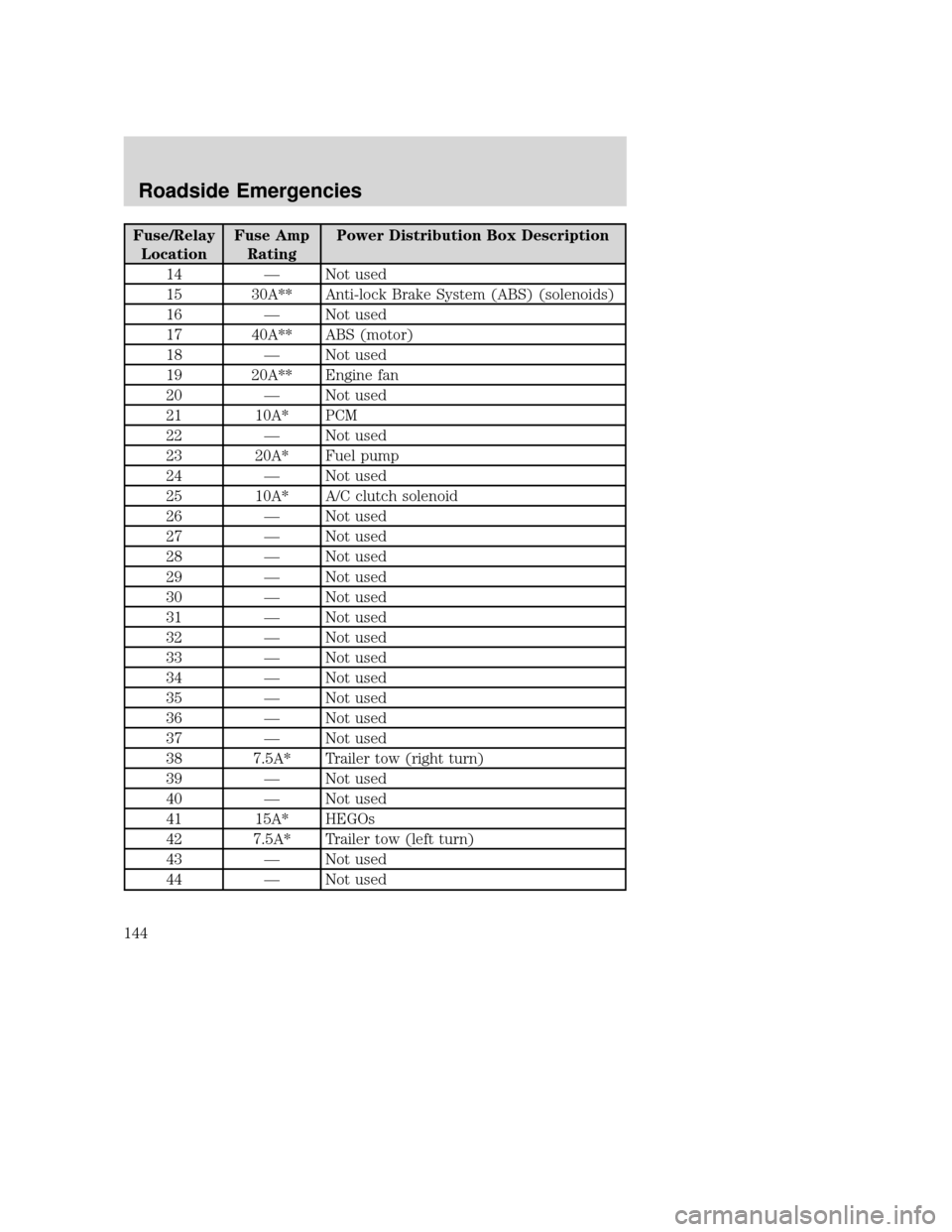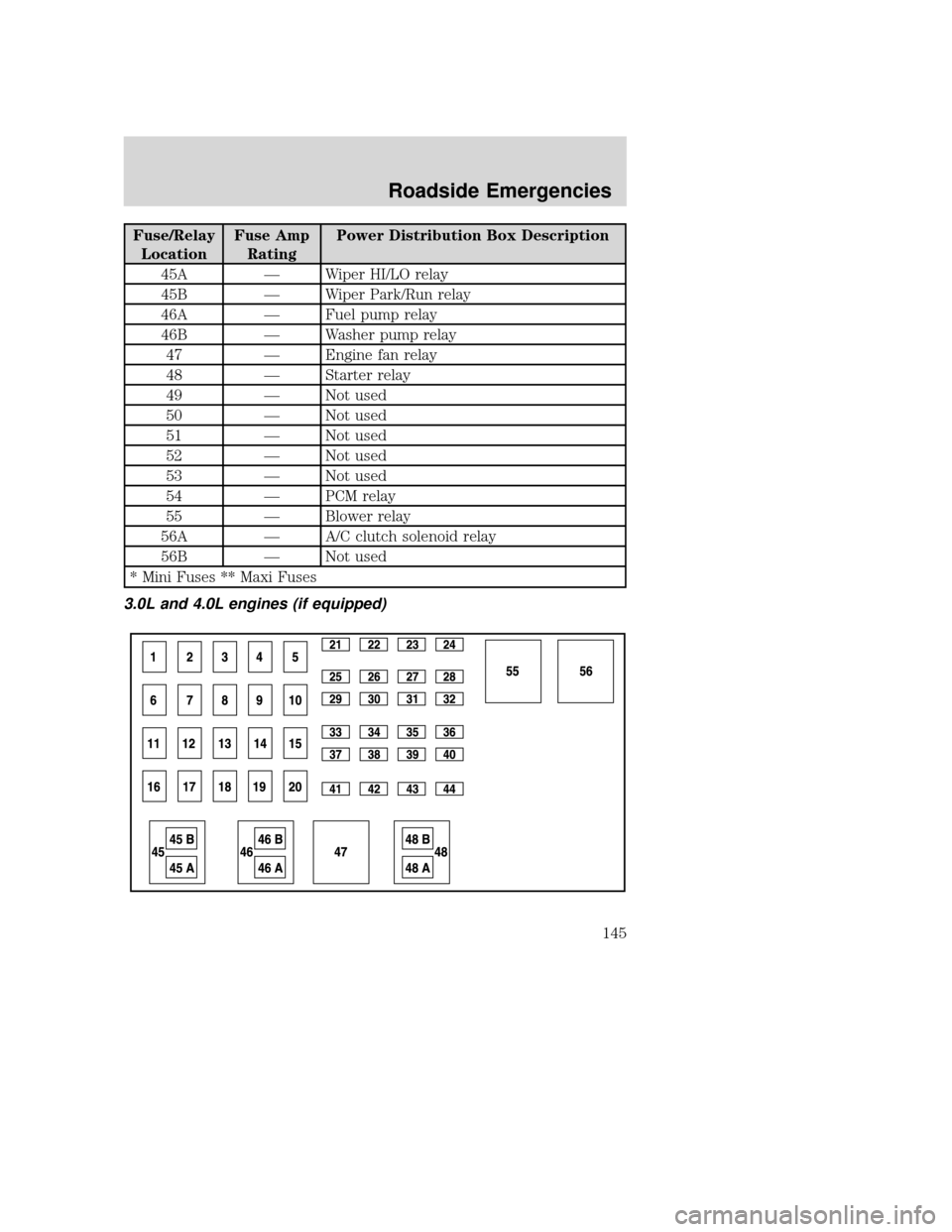engine MAZDA MODEL B-SERIES 2004 (in English) Service Manual
[x] Cancel search | Manufacturer: MAZDA, Model Year: 2004, Model line: MODEL B-SERIES, Model: MAZDA MODEL B-SERIES 2004Pages: 256, PDF Size: 1.97 MB
Page 142 of 256

Fuse/RelayLocation Fuse Amp
Rating Passenger Compartment Fuse Panel
Description
32 5A Brake switch (logic)
33 5A Instrument cluster
34 20A Power point
35 15A Power locks
Power distribution box
The power distribution box is
located in the engine compartment.
The power distribution box contains
high-current fuses that protect your
vehicle’ s main electrical systems
from overloads.
WARNING: Always disconnect the battery before servicing
fuses.
WARNING: To reduce risk of electrical shock, always replace
the cover to the Power Distribution Box before reconnecting
the battery or refilling fluid reservoirs.
If the battery has been disconnected and reconnected, refer to the
Battery section of the Maintenance and specifications chapter.
2004 Mazda B Series(mbs)
Owners Guide (post-2002-fmt)
Canadian French (fr-can)
Roadside Emergencies
142
Page 143 of 256

2.3L engine (if equipped)
The high-current fuses are coded as follows:
Fuse/RelayLocation Fuse Amp
Rating Power Distribution Box Description
1 50A** Passenger compartment fuse panel
2 —Not used
3 50A** Passenger compartment fuse panel
4 —Not used
5 50A** Passenger compartment fuse panel
6 —Not used
7 40A** Starter relay fuse
8 —Not used
9 40A** Ignition switch
10 —Not used
11 30A** Powertrain Control Module (PCM), Engine sensors
12 —Not used
13 30A** Blower motor (climate control)
1234521 22 23 24
25 26 27 28
29 30 31 32
33 34 35 36
37 38 39 40
41 42 43 44
678910 55
49
48 54
5352
51 56
56 B
56 A
50 50 B
50 A
47
45 45 B
45 A
4646 B
46 A
11 12 13 14 15
16 17 18 19 20
2004 Mazda B Series
(mbs)
Owners Guide (post-2002-fmt)
Canadian French (fr-can)
Roadside Emergencies
143
Page 144 of 256

Fuse/RelayLocation Fuse Amp
Rating Power Distribution Box Description
14 —Not used
15 30A** Anti-lock Brake System (ABS) (solenoids)
16 —Not used
17 40A** ABS (motor)
18 —Not used
19 20A** Engine fan
20 —Not used
21 10A* PCM
22 —Not used
23 20A* Fuel pump
24 —Not used
25 10A* A/C clutch solenoid
26 —Not used
27 —Not used
28 —Not used
29 —Not used
30 —Not used
31 —Not used
32 —Not used
33 —Not used
34 —Not used
35 —Not used
36 —Not used
37 —Not used
38 7.5A* Trailer tow (right turn)
39 —Not used
40 —Not used
41 15A* HEGOs
42 7.5A* Trailer tow (left turn)
43 —Not used
44 —Not used
2004 Mazda B Series (mbs)
Owners Guide (post-2002-fmt)
Canadian French (fr-can)
Roadside Emergencies
144
Page 145 of 256

Fuse/RelayLocation Fuse Amp
Rating Power Distribution Box Description
45A —Wiper HI/LO relay
45B —Wiper Park/Run relay
46A —Fuel pump relay
46B —Washer pump relay
47 —Engine fan relay
48 —Starter relay
49 —Not used
50 —Not used
51 —Not used
52 —Not used
53 —Not used
54 —PCM relay
55 —Blower relay
56A —A/C clutch solenoid relay
56B —Not used
* Mini Fuses ** Maxi Fuses
3.0L and 4.0L engines (if equipped)
2004 Mazda B Series (mbs)
Owners Guide (post-2002-fmt)
Canadian French (fr-can)
Roadside Emergencies
145
Page 148 of 256

OVERHEATING
If the temperature gauge indicates overheating and you experience
power loss, you hear a loud knocking or pinging noise, the engine is
probably too hot.
If this happens:1. Drive safely to the side of the road and park off the right-of-way.
2. Shift the automatic transmission into P (Park) or the manual transmission into the neutral position, and apply the parking brake.
3. Turn off the air conditioner.
WARNING: Steam from an overheated engine is dangerous. The
escaping steam could seriously burn you. Open the hood ONLY
after steam is no longer escaping from the engine.
4. Check whether coolant or steam is escaping from under the hood or from the engine compartment.
• If steam is coming from the engine compartment: do not go near
the front of the vehicle. Stop the engine, then turn the ignition switch
to the ON position without starting the engine. The radiator cooling
fans will start to cool the engine.
• If neither coolant nor steam is escaping: open the hood and idle
the engine until it cools. If this does not lower the temperature, stop
the engine and let it cool.
5. Check the coolant level. If it is low, look for leaks in the radiator hoses and connections, heater hoses and connections, radiator and
water pump.
If you find a leak or other damage, or if coolant is still leaking, stop the
engine and call an Authorized Mazda dealer.
See Adding coolant in theMaintenance and specifications section. If
you find no problems, the engine is cool and no leaks are obvious,
carefully add coolant as required.
WARNING: When the engine and radiator are hot, scalding
coolant and steam may shoot out under pressure and cause
serious injury. Do not remove the cooling system cap when the
engine and radiator are hot.
Note: If the engine continues to overheat or frequently overheats, have
the cooling system inspected. The engine could be seriously damaged
unless repairs are made.
2004 Mazda B Series (mbs)
Owners Guide (post-2002-fmt)
Canadian French (fr-can)
Roadside Emergencies
148
Page 153 of 256

1. Park on a level surface, activatehazard flashers and place
gearshift lever in P (Park)
(automatic transmission) or 1
(First) (manual transmission).
2. Set the parking brake and turn engine OFF.
3. Block the diagonally opposite wheel.
4. Insert tapered end of the lug wrench behind hub caps and
twist them off.
5. Loosen each wheel lug nut one-half turn counterclockwise
but do not remove them until
the wheel is raised off the
ground.
6. Position the jack according to the following guides and turn
the jack handle clockwise until the tire is a maximum of 25 mm (1
inch) off the ground.
2004 Mazda B Series (mbs)
Owners Guide (post-2002-fmt)
Canadian French (fr-can)
Roadside Emergencies
153
Page 154 of 256

WARNING: To lessen the risk
of personal injury, do not put
any part of your body under
the vehicle while changing a
tire. Do not start the engine
when your vehicle is on the
jack. The jack is only meant
for changing the tire.
• Front
• Rear
Never use the differential as a
jacking point. It is too easy for
the vehicle to tilt or fall and you
can be injured. 7. Remove the wheel lug nuts with the lug wrench.
8. Replace the flat tire with the spare tire, making sure the valve
stem is facing outward. Reinstall
the lug nuts until the wheel is
snug against the hub. Do not fully tighten the lug nuts until the
wheel has been lowered.
9. Lower the wheel by turning the jack handle counterclockwise.
2004 Mazda B Series (mbs)
Owners Guide (post-2002-fmt)
Canadian French (fr-can)
Roadside Emergencies
154
Page 157 of 256

3. Park the booster vehicle close to the hood of the disabled vehiclemaking sure the two vehicles do nottouch. Set the parking brake on
both vehicles and stay clear of the engine cooling fan and other
moving parts.
4. Check all battery terminals and remove any excessive corrosion before you attach the battery cables. Ensure that vent caps are tight
and level.
5. Turn the heater fan on in both vehicles to protect any electrical surges. Turn all other accessories off.
Connecting the jumper cables
1. Connect the positive (+) jumper cable to the positive (+) terminal of the discharged battery.
Note: In the illustrations, lightning boltsare used to designate the
assisting (boosting) battery.
2. Connect the other end of the positive (+) cable to the positive (+) terminal of the assisting battery.
+–+–
+–+–
2004 Mazda B Series (mbs)
Owners Guide (post-2002-fmt)
Canadian French (fr-can)
Roadside Emergencies
157
Page 158 of 256

3. Connect the negative (-) cable to the negative (-) terminal of theassisting battery.
4. Make the final connection of the negative (-) cable to an exposed metal part of the stalled vehicle’ s engine, away from the battery and
the fuel injection system. Do notuse fuel lines, engine rocker covers
or the intake manifold as groundingpoints.
WARNING: Do not connect the end of the second cable to the
negative (-) terminal of the battery to be jumped. A spark may
cause an explosion of the gases that surround the battery.
5. Ensure that the cables are clear of fan blades, belts, moving parts of both engines, or any fuel delivery system parts.
Jump starting 1. Start the engine of the booster vehicle and run the engine at moderately increased speed.
2. Start the engine of the disabled vehicle.
+–+–
+–+–
2004 Mazda B Series (mbs)
Owners Guide (post-2002-fmt)
Canadian French (fr-can)
Roadside Emergencies
158
Page 159 of 256

3. Once the disabled vehicle has been started, run both engines for anadditional three minutes before disconnecting the jumper cables.
Removing the jumper cables
Remove the jumper cables in the reverse order that they were
connected. 1. Remove the jumper cable from the groundmetal surface.
Note: In the illustrations, lightning boltsare used to designate the
assisting (boosting) battery.
2. Remove the jumper cable on the negative (-) connection of the booster vehicle’ s battery.
+–+–
+–+–
2004 Mazda B Series (mbs)
Owners Guide (post-2002-fmt)
Canadian French (fr-can)
Roadside Emergencies
159